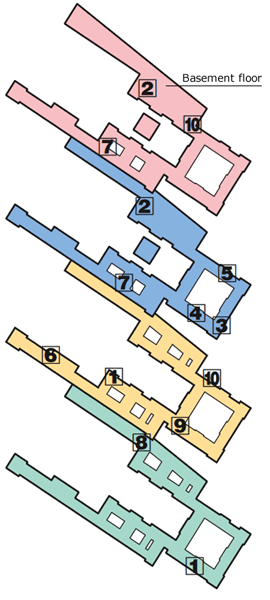Louvre Collections

Collections floorplan
French Paintings
This
superb collection ranges from the 14th century to 1848 and includes
works by such artists as Jean Watteau, Georges de la Tour and JH
Fragonard.
French Sculpture
Highlights include the Tomb of Philippe Pot by Antoine le Moiturier, the Marly Horses and works by Pierre Puget in the glass-covered courtyards.
Egyptian Antiquities
The
finest collection outside Cairo, featuring a Sphinx in the crypt, the
Seated Scribe of Sakkara, huge sarcophagi, mummified animals, funerary
objects and intricate carvings depicting everyday life in Ancient Egypt.

Akhenaton and Nefertiti, Egypt
Greek Antiquities
The
wondrous art of Ancient Greece here ranges from a Cycladic idol from
the third millennium BC to Classical Greek marble statues (c.5th century BC) to Hellenistic works (late 3rd–2nd century BC).
Oriental Antiquities
A
stunning collection includes a re-created temple of an Assyrian king
and the Codex of Hammurabi (18th century BC), mankind’s oldest written
laws.
Italian Paintings
French
royalty adored the art of Italy and amassed much of this collection
(1200–1800). There are many works by da Vinci including the Mona Lisa.

Collections floorplan
Italian Sculpture
Highlights of this collection, dating from the early Renaissance, include a 15th-century Madonna and Child by Donatello and Michelangelo’s
Slaves
.
Dutch Paintings
Rembrandt works take pride of place in this section, along with domestic scenes by Vermeer and portraits by Frans Hals.
Objets d’Art
This collection of ceramics, jewellery and other items spans many countries and centuries.
Islamic Art
An exquisite collection ranging from the 7th century to the Ottoman Empire (14th–19th centuries). Closed for renovation.
Leonardo da Vinci and the Mona Lisa
Born in Vinci to a
wealthy family, Leonardo da Vinci (1452–1519) first took up an
apprenticeship under the Florentine artist Andrea del Verrocchio, then
served the Duke of Milan as an architect and military engineer, during
which time he painted the acclaimed Last Supper mural (1495). On his return to Florence, to work as architect to Cesare Borgia, he painted his most celebrated portrait, the Mona Lisa (1503–06). It is also known as La Gioconda,
allegedly the name of the model’s aristocratic husband, although recent
speculation suggests that da Vinci himself could be the subject. The
masterpiece, particularly the sitter’s mysterious smile, shows mastery
of two techniques: chiaroscuro, the contrast of light and shadow, and sfumato,
subtle transitions between colours. It was the artist’s own favourite
painting and he took it with him everywhere. In 1516 François I brought
them both to France, giving da Vinci the use of a manor house in Amboise
in the Loire Valley, where he died three years later. The Mona Lisa is the Renaissance master’s only known surviving work of portraiture.

Mona Lisa, Leonardo da Vinci’s enigmatic portrait
Leonardo da Vinci
A Renaissance man extraordinaire, Leonardo was not only an artist
but a sculptor, engineer, architect and scientist. His many
achievements included the study of anatomy and aerodynamics.

Top 10 Louvre ResidentsCatherine de’ Medici (1519–89)
Anne of Austria (1601–66)
Guillaume Coustou, sculptor (1677–1746)
Edmé Bouchardon, sculptor (1698–1762)
François Boucher, artist (1703–70)